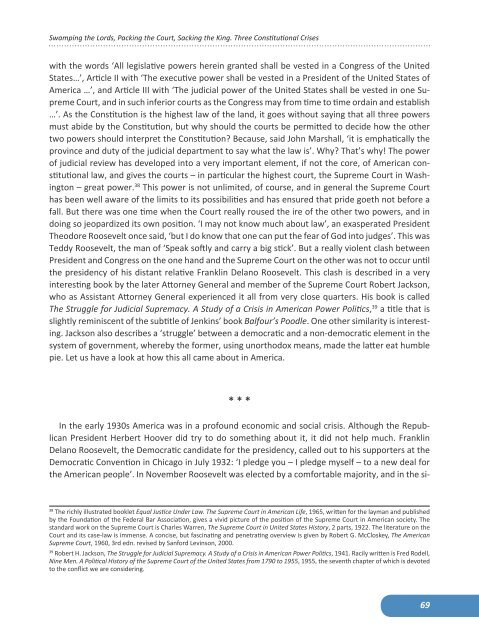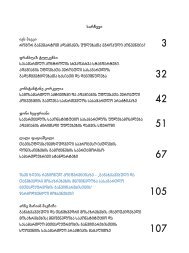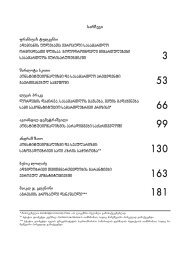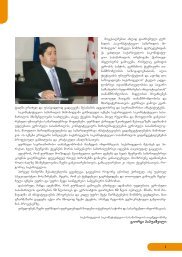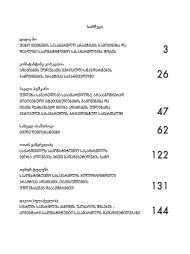Contents - Constitutional Court of Georgia
Contents - Constitutional Court of Georgia
Contents - Constitutional Court of Georgia
Create successful ePaper yourself
Turn your PDF publications into a flip-book with our unique Google optimized e-Paper software.
Swamping the Lords, Packing the <strong>Court</strong>, Sacking the King. Three <strong>Constitutional</strong> Crises<br />
with the words ‘All legislative powers herein granted shall be vested in a Congress <strong>of</strong> the United<br />
States…’, Article II with ‘The executive power shall be vested in a President <strong>of</strong> the United States <strong>of</strong><br />
America …’, and Article III with ‘The judicial power <strong>of</strong> the United States shall be vested in one Supreme<br />
<strong>Court</strong>, and in such inferior courts as the Congress may from time to time ordain and establish<br />
…’. As the Constitution is the highest law <strong>of</strong> the land, it goes without saying that all three powers<br />
must abide by the Constitution, but why should the courts be permitted to decide how the other<br />
two powers should interpret the Constitution? Because, said John Marshall, ‘it is emphatically the<br />
province and duty <strong>of</strong> the judicial department to say what the law is’. Why? That’s why! The power<br />
<strong>of</strong> judicial review has developed into a very important element, if not the core, <strong>of</strong> American constitutional<br />
law, and gives the courts – in particular the highest court, the Supreme <strong>Court</strong> in Washington<br />
– great power. 38 This power is not unlimited, <strong>of</strong> course, and in general the Supreme <strong>Court</strong><br />
has been well aware <strong>of</strong> the limits to its possibilities and has ensured that pride goeth not before a<br />
fall. But there was one time when the <strong>Court</strong> really roused the ire <strong>of</strong> the other two powers, and in<br />
doing so jeopardized its own position. ‘I may not know much about law’, an exasperated President<br />
Theodore Roosevelt once said, ‘but I do know that one can put the fear <strong>of</strong> God into judges’. This was<br />
Teddy Roosevelt, the man <strong>of</strong> ‘Speak s<strong>of</strong>tly and carry a big stick’. But a really violent clash between<br />
President and Congress on the one hand and the Supreme <strong>Court</strong> on the other was not to occur until<br />
the presidency <strong>of</strong> his distant relative Franklin Delano Roosevelt. This clash is described in a very<br />
interesting book by the later Attorney General and member <strong>of</strong> the Supreme <strong>Court</strong> Robert Jackson,<br />
who as Assistant Attorney General experienced it all from very close quarters. His book is called<br />
The Struggle for Judicial Supremacy. A Study <strong>of</strong> a Crisis in American Power Politics, 39 a title that is<br />
slightly reminiscent <strong>of</strong> the subtitle <strong>of</strong> Jenkins’ book Balfour’s Poodle. One other similarity is interesting.<br />
Jackson also describes a ‘struggle’ between a democratic and a non-democratic element in the<br />
system <strong>of</strong> government, whereby the former, using unorthodox means, made the latter eat humble<br />
pie. Let us have a look at how this all came about in America.<br />
* * *<br />
In the early 1930s America was in a pr<strong>of</strong>ound economic and social crisis. Although the Republican<br />
President Herbert Hoover did try to do something about it, it did not help much. Franklin<br />
Delano Roosevelt, the Democratic candidate for the presidency, called out to his supporters at the<br />
Democratic Convention in Chicago in July 1932: ‘I pledge you – I pledge myself – to a new deal for<br />
the American people’. In November Roosevelt was elected by a comfortable majority, and in the si-<br />
38 The richly illustrated booklet Equal Justice Under Law. The Supreme <strong>Court</strong> in American Life, 1965, written for the layman and published<br />
by the Foundation <strong>of</strong> the Federal Bar Association, gives a vivid picture <strong>of</strong> the position <strong>of</strong> the Supreme <strong>Court</strong> in American society. The<br />
standard work on the Supreme <strong>Court</strong> is Charles Warren, The Supreme <strong>Court</strong> in United States History, 2 parts, 1922. The literature on the<br />
<strong>Court</strong> and its case-law is immense. A concise, but fascinating and penetrating overview is given by Robert G. McCloskey, The American<br />
Supreme <strong>Court</strong>, 1960, 3rd edn. revised by Sanford Levinson, 2000.<br />
39 Robert H. Jackson, The Struggle for Judicial Supremacy. A Study <strong>of</strong> a Crisis in American Power Politics, 1941. Racily written is Fred Rodell,<br />
Nine Men. A Political History <strong>of</strong> the Supreme <strong>Court</strong> <strong>of</strong> the United States from 1790 to 1955, 1955, the seventh chapter <strong>of</strong> which is devoted<br />
to the conflict we are considering.<br />
69


